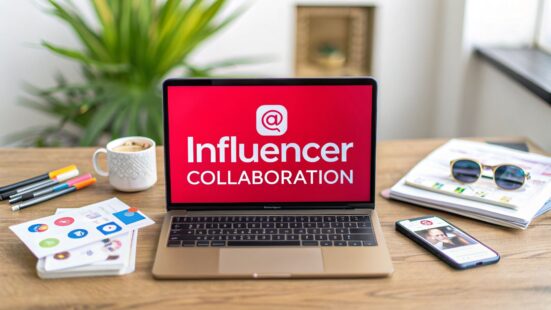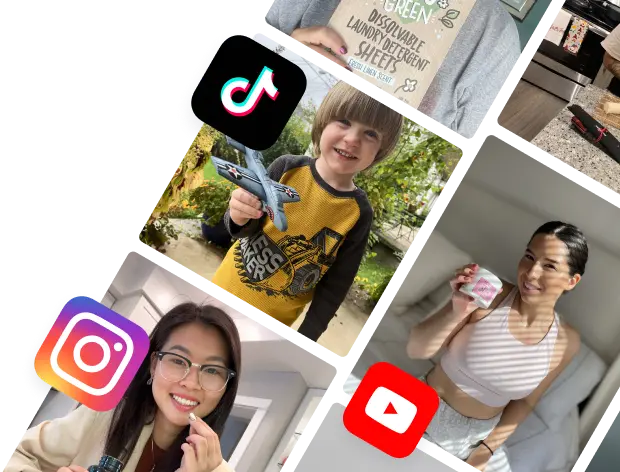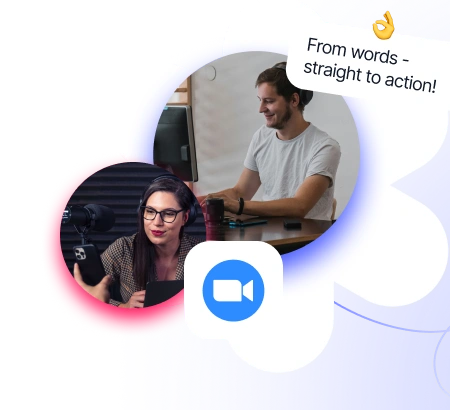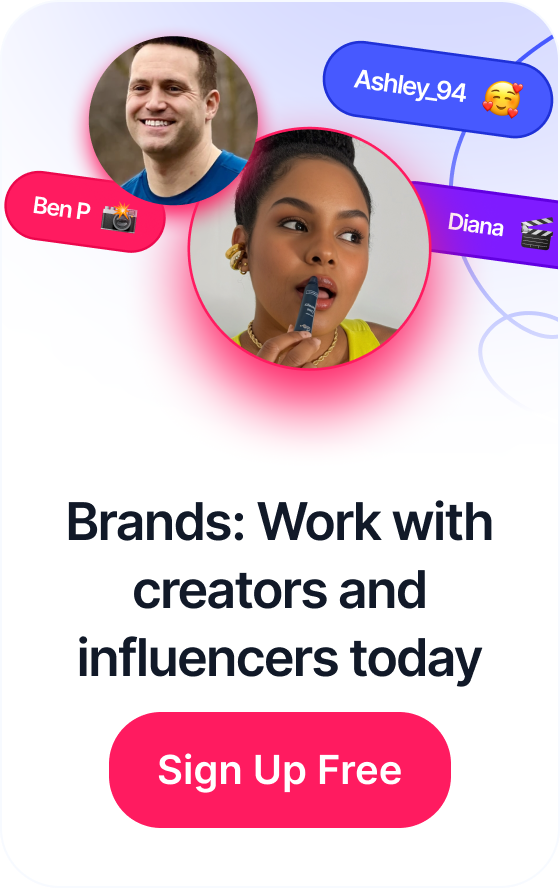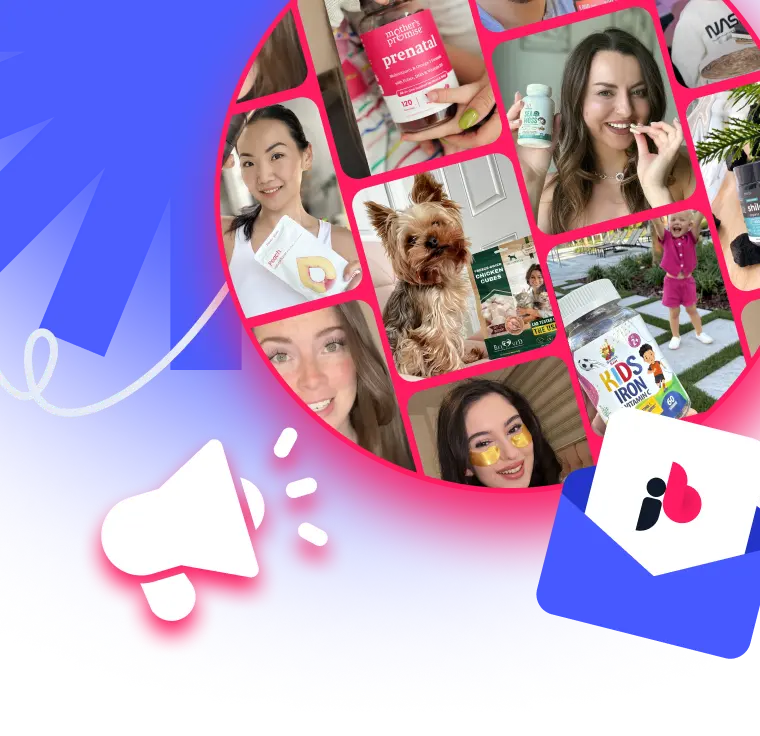 How to Make UGC That Drives Authentic Brand Growth
How to Make UGC That Drives Authentic Brand Growth
Before you even think about sliding into an influencer's DMs, you need a rock-solid internal strategy. This is the non-negotiable first step. It’s all about defining clear goals, figuring out a realistic budget, and hammering out a detailed brief to guide the whole partnership. Getting this foundation right is what separates a chaotic, money-pit of a campaign from a truly successful one.
Table of Contents
Building Your Foundation for Influencer Collaboration

Jumping into influencer outreach without a plan is like setting sail without a map. Sure, you'll end up somewhere, but it probably won't be where you wanted to go. From my experience, the collaborations that really knock it out of the park are built on a bedrock of clear objectives and mutual understanding from day one.
This initial planning phase is what keeps your efforts focused, measurable, and perfectly in sync with your bigger marketing picture.
The explosive growth of this industry is exactly why this prep work is so critical. The global influencer marketing market is on track to hit a staggering $32.55 billion by 2025. More telling is that over 80% of marketers swear by it as an effective strategy. Brands are trusting these partnerships more and more, which makes a strategic, thoughtful approach more important than ever.
Define Your Campaign Goals
First things first, you have to ask the big question: What are we actually trying to achieve here?
Your answer will dictate every single decision you make next—from the kind of influencer you partner with to the content they end up creating. Vague goals like "increase brand awareness" just don't cut it. You have to get specific.
What's the primary objective? It usually boils down to one of these:
- Driving Sales: This is all about the bottom line. Success here is measured with things you can count, like trackable affiliate links, unique discount codes, and, of course, conversion rates.
- Generating User-Generated Content (UGC): The goal here is to get your hands on authentic photos and videos from creators. This content is gold because you can repurpose it everywhere—in your social media ads, on your product pages, and across your website.
- Boosting Brand Awareness: This is about getting your name in front of a new, highly relevant audience. You'll be tracking metrics like reach, impressions, and follower growth to see if you're making a dent.
A well-defined goal is your campaign's north star. It guides your strategy, helps you measure ROI accurately, and keeps everyone—you and your influencer—on the same page about what success looks like from the get-go.
To make sure you're tracking the right things, it's crucial to align your goals with the right Key Performance Indicators (KPIs). Mismatching these is a common mistake that leads to confusion about whether a campaign actually worked.
Matching Your Campaign Goals to the Right KPIs
This table helps you align your primary campaign objectives with the right key performance indicators (KPIs) to track success accurately.
| Campaign Goal | Primary KPI | Example Metric |
|---|---|---|
| Increase Brand Awareness | Reach & Impressions | Total number of unique views |
| Drive Website Traffic | Click-Through Rate (CTR) | Percentage of users who clicked the link |
| Generate Sales | Conversion Rate | Number of sales from a unique discount code |
| Build Community | Engagement Rate | Likes, comments, shares per post |
| Collect UGC | Content Volume | Number of high-quality assets received |
By pairing the right goal with the right KPI, you get a crystal-clear picture of your campaign's performance and can prove its value without any guesswork.
Set a Realistic Budget
Your budget is the engine that powers your campaign. It dictates the scale, scope, and the caliber of influencers you can bring on board. But it's about way more than just the influencer's fee. A comprehensive budget has a few moving parts.
Be sure to account for these key costs:
- Influencer Compensation: This could be a flat fee, a commission on sales (affiliate model), or a hybrid of both.
- Product Costs: Don't forget the cost of the products you're sending out, including shipping and handling. For a great breakdown of what this entails, check out this guide on What is a PR Package: A Complete Guide for Brands & Influencers.
- Ad Spend: Set aside some cash to boost the influencer’s content. This lets you amplify their great work and reach an even wider, more targeted audience.
- Platform Fees: If you’re using a platform like JoinBrands to find and manage creators, you'll need to factor in any subscription or campaign fees. It’s an investment that can save a ton of time and headaches.
Finding Influencers Who Align with Your Brand
Once your strategy is locked in, the real hunt begins. And let's be honest, finding the right influencer is less about chasing huge follower counts and much more about finding a genuine partner. Someone whose audience and values actually line up with your own.
Get this part wrong, and your campaign can sink before it even starts. You'll end up with content that feels forced, disconnected, and a total waste of money. The goal here is to dig deeper than surface-level metrics. You need to look at engagement rates, audience demographics, and the actual quality of their content to find someone who will be a true advocate, not just a temporary billboard.

Look Beyond the Follower Count
A massive following doesn't automatically mean massive results. I've seen it time and time again—the real magic often happens with smaller, more connected communities. This is where understanding the different tiers of influencers becomes a game-changer for matching your budget to your goals.
- Nano-Influencers (1k-10k followers): These creators are gold for hyper-targeted campaigns. Their audiences are often super niche and trust them implicitly. If you need authenticity above all else, start here.
- Micro-Influencers (10k-100k followers): This is often the sweet spot. They strike a great balance between solid reach and strong community engagement. They're seen as experts and have a real knack for swaying purchasing decisions.
- Macro-Influencers (100k-1M+ followers): Think of these as the celebrities of social media. They offer incredible reach for big brand awareness pushes, but they come with a hefty price tag and, often, lower engagement rates.
The numbers for micro-influencers are especially compelling. Their engagement rate averages around 3.86%, which is a clear sign their followers are actually paying attention. And considering that 79% of marketers name Instagram as their go-to platform, knowing which tier and platform to focus on is critical.
Don't just look at who an influencer is; look at who follows them. An influencer with 50,000 followers who are your ideal customers is infinitely more valuable than one with 500,000 followers who aren't.
Vet Your Potential Partners Thoroughly
Okay, so you've built a list of potential collaborators. Now it's time to do your homework. This isn't just a formality—a thorough vetting process is what protects you from red flags and confirms you've found a legitimate partner for your brand.
Skipping this step is a rookie mistake. Proper vetting protects your brand’s reputation and makes sure your investment is sound. Start by just scrolling through their feed. Does their vibe match yours? Is their tone of voice a good fit? Our guide on how to find the right influencers for your brand goes way deeper into these crucial evaluation steps.
Here’s what I always look for during a review:
- Quality of Audience Engagement: Don't just count the likes. Read the comments. Are people having real conversations, or is it just a wall of fire emojis and spam bots? Genuine back-and-forth means you’ve found an active, loyal community.
- Content Consistency and Authenticity: Do they post regularly? Is there a consistent theme or is their feed all over the place? Also, scope out their past brand deals. You want to steer clear of anyone who promotes your direct competitors or whose sponsored posts sound like a robot wrote them.
- Audience Demographics Alignment: This is non-negotiable. Use tools to analyze their follower demographics—make sure their audience's age, location, and interests are a perfect match for your target customer.
Mastering Outreach and Building Real Connections

Alright, you've got your vetted shortlist of creators. Now for the fun part: making contact. How you approach an influencer can genuinely make or break the entire collaboration before it even starts.
Let's be real—seasoned creators get dozens of pitches a day. A generic, copy-paste template is an instant delete. The only way to cut through that noise is with genuine personalization.
This first message sets the tone for everything that follows. You have to show them you’ve done your homework. Mention a specific post or video you actually enjoyed and explain why you think their unique voice and audience are a perfect match for your brand. This isn't just flattery; it's a sign of respect for their work.
Crafting the Perfect Pitch
Your first message, whether it’s a DM or an email, needs to be sharp, compelling, and focused on what’s in it for them. Influencers are business owners, so get to the point, but keep the tone friendly and human. Ditch the vague compliments and get specific.
For example, instead of, "We love your content," try something like, "Your recent video on sustainable morning routines really hit home for us, especially the part about reducing plastic waste. We think our compostable coffee pods would be a natural fit for your audience."
See the difference? That small shift shows you're not just blasting out messages to a random list. If you need more pointers, our detailed guide on https://joinbrands.com/blog/influencer-marketing-outreach/ is packed with actionable strategies. And if you're just looking for a structural starting point, exploring some powerful cold email templates can help spark ideas for your own personalized versions.
A great outreach message is a conversation starter, not a contract. The goal is to open a dialogue and build a relationship, not just to present a demand. Focus on what makes the partnership a win-win.
Negotiating Fair and Clear Terms
Once an influencer expresses interest, the conversation will naturally shift to negotiations. This is where transparency becomes non-negotiable. Being upfront and ready to discuss terms openly builds trust and prevents the kind of misunderstandings that can sour a partnership down the line.
And don't just think in terms of a single flat fee. Different compensation models work for different campaigns and creators.
- Flat Fee: A simple, one-time payment for specific deliverables. This is pretty standard for established creators with predictable engagement.
- Commission/Affiliate: The creator earns a percentage of sales from their unique link or code. It’s a performance-driven model that can be incredibly effective.
- Product Seeding: Gifting products in exchange for an honest review or post. This is a great entry point, especially with nano or micro-influencers who already love what you do.
- Hybrid Model: This is often the sweet spot—a combination of a base fee plus a commission structure. It gives the creator security while also incentivizing top performance.
Beyond the payment, you absolutely must be crystal clear about content usage rights. Define exactly where and for how long you can repurpose their content. Spelling this out from the get-go protects both you and the creator, setting the stage for a smooth, successful partnership built on mutual respect.
Managing Your Campaign Workflow Seamlessly
The contracts are signed, the creator is excited—now the real work begins. This is where a campaign lives or dies. Without a solid workflow, even the most promising partnership can dissolve into a mess of missed deadlines, frustrating back-and-forths, and content that just doesn't hit the mark.
To really collaborate effectively with influencers, you need a clear, repeatable process. Think of it as the project management backbone of your campaign, covering everything from getting products into their hands to the moment their content goes live. A good system ensures a smooth ride for both you and the creator, preventing micromanagement and keeping everything on track.
Establishing Clear Communication and Approval Loops
If there's one thing that can derail a collaboration, it's messy communication. The first thing you need to do is set up a single, central channel for all campaign discussions. Get out of disjointed email threads and random DMs. Use a dedicated Slack channel, a project management tool like Asana, or the built-in live chat on a platform like JoinBrands to keep everything in one place.
Next up is the content approval process. This is a balancing act. You hired the creator for their unique voice and connection with their audience, but you still need to protect your brand. Stifling their creativity with too much oversight is the fastest way to get bland, inauthentic content.
Instead, create a simple, multi-stage review system. The goal is to provide guardrails, not a straitjacket.
This workflow is a great example of how to structure the process. It respects the creator's freedom while making sure the final post is perfectly aligned with your brand.
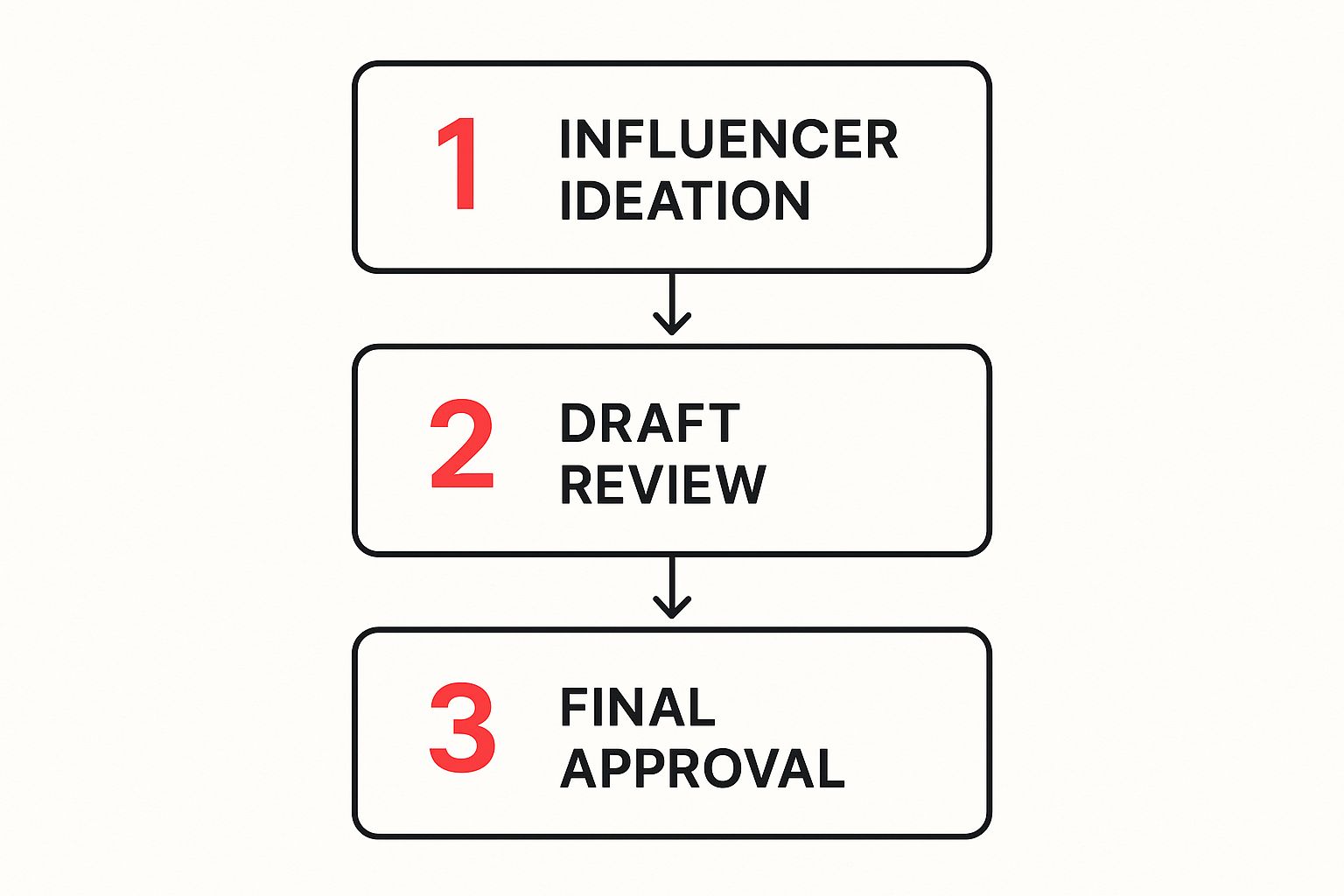
A structured approach like this gets rid of last-minute fire drills and gives creators a clear roadmap, which means far fewer revisions for everyone.
Shipping Products and Tracking Deliverables
With your communication lines open, it's time to ship the product. But don't just send it off and cross your fingers. Track that package and give the creator a heads-up when it's delivered. It's a small touch, but it shows you're organized and invested.
When you're juggling multiple influencers, a centralized tracking system is non-negotiable. While a basic spreadsheet can get the job done in a pinch, specialized platforms are a game-changer because they automate so much of this.
At a minimum, you need to track these key dates for every creator:
- Product Shipped Date: When you sent the product.
- Content Draft Due Date: The deadline for their first pass.
- Feedback Provided Date: When your team gave notes.
- Final Content Due Date: The deadline for the approved version.
- Scheduled Live Date: The agreed-upon publish date.
Giving good feedback is an art. Don't just say, "I don't like it." Get specific. Try something like, "Could we get a shot that shows the product's texture more clearly? Our audience really responds to those kinds of details." Actionable advice always leads to better content.
Handling Payments and Unexpected Hurdles
Finally, make sure your payment process is just as buttoned-up as the rest of your workflow. Pay influencers on time, every time, based on the terms in your contract. Nothing sours a great relationship faster than chasing down a late payment. It’s a surefire way to get a bad reputation in the creator community.
Of course, even the best-laid plans can go sideways. A product might arrive damaged, a creator could get sick, or a post might not perform as expected. When things go wrong, stay flexible and keep the lines of communication wide open. The goal is always to find a solution together. It's an opportunity to strengthen the partnership, not let it fracture under pressure.
Measuring Success and Nurturing Long-Term Partnerships
Once the content is live and the likes start rolling in, it’s easy to feel like the job is done. But the real work is just beginning. How do you actually know if the collaboration moved the needle for your business?
Measuring your return on investment (ROI) is the final, crucial step in understanding what worked, what didn't, and proving the value of your efforts.
This means looking far beyond simple vanity metrics. While high engagement is great, it doesn't always translate to sales or brand growth. True measurement connects the campaign's performance directly back to the specific goals you set in the very beginning.
Tying Metrics to Your Original Goals
If your goal was to drive sales, likes are irrelevant. You need to focus on hard numbers. This is where tracking mechanisms become your best friends.
You have a few solid options here:
- Unique Discount Codes: Assigning a specific code (like CREATOR15) to each influencer is one of the simplest and most effective ways to track direct sales. It leaves no doubt about where a purchase came from.
- UTM Links: These are customized URLs that feed data directly into your analytics software, like Google Analytics. You can see exactly how many people clicked through from an influencer’s content and what they did on your site.
For awareness campaigns, you’ll focus more on metrics like reach (the number of unique people who saw the content) and impressions (the total number of times the content was displayed). Digging into the comments to analyze audience sentiment also provides valuable qualitative data on how the collaboration landed with their followers.
A successful campaign isn't just one with pretty pictures; it's one with a clear data story. Compile everything into a post-campaign report to analyze performance, share key learnings, and make smarter decisions for your next collaboration.
Tracking ROI is essential for knowing what works. Different methods provide different insights, so choosing the right one depends on your campaign goals. Here’s a quick breakdown of common tracking methods to help you decide.
ROI Tracking Methods for Influencer Collaborations
| Tracking Method | What It Measures | Best For |
|---|---|---|
| Discount Codes | Direct sales attributed to a specific influencer. | E-commerce brands focused on immediate sales conversions. |
| UTM Parameters | Website traffic, click-through rates, and on-site behavior from specific links. | Brands wanting to track the entire customer journey from social media to their website. |
| Affiliate Links | Sales and commissions generated through a unique link, often tracked via a platform. | Performance-based campaigns where influencers earn a percentage of sales. |
| Reach & Impressions | The number of unique viewers and total views of the content. | Brand awareness campaigns where the goal is maximizing visibility. |
| Engagement Rate | Likes, comments, shares, and saves relative to follower count or reach. | Campaigns focused on building community and generating conversation. |
| Audience Sentiment | The tone and context of comments and mentions (positive, negative, neutral). | Understanding brand perception and the qualitative impact of a collaboration. |
By using a mix of these methods, you get a much richer picture of a campaign's total impact. A discount code might show you the direct sales, while UTMs can reveal how many new visitors you gained.
The Power of Long-Term Partnerships
A single successful campaign is fantastic, but the real value is unlocked when you turn that one-off project into an ongoing relationship. When an influencer consistently works with your brand, they become a true ambassador.
Their audience sees them using your products over and over, which builds incredible trust and authenticity.
This shift from a transactional relationship to a genuine partnership has huge benefits. The influencer develops a deeper understanding of your brand, leading to more creative and impactful content. Their followers come to associate your brand with a trusted source, making their recommendations feel more like advice from a friend than a sponsored ad.
One of the most important aspects of maintaining this relationship is ensuring timely and fair compensation. Navigating how to pay influencers correctly is fundamental to building trust and showing you value their work.
Turning Collaborators into Brand Ambassadors
So, how do you nurture these long-term bonds? It starts with treating influencers like the valuable partners they are.
- Share Performance Data: Be transparent. Sharing the wins helps them understand what resonates with their audience and makes them feel like part of the team.
- Offer Exclusivity or First Looks: Give your top-performing partners early access to new products or the chance to be the face of a new launch. This makes them feel valued and invested.
- Establish a Retainer: For your most trusted creators, consider moving to a monthly retainer. This provides them with stable income and gives you a steady stream of authentic content—a true win-win for building a lasting partnership.
Common Questions About Influencer Collaboration
So, you're diving into the world of influencer marketing. It can feel like you're learning a whole new language, right? You've got your strategy down, you know how to spot the right creators, and you've even gotten the hang of outreach. But then, right as you're about to pull the trigger, a few practical questions always seem to surface.
Getting clear answers to these is crucial. It’s the difference between fumbling through your first few campaigns and navigating the process with confidence. Knowing this stuff helps you avoid rookie mistakes and build solid, professional relationships with creators from day one.
How Much Should I Pay an Influencer?
This is the big one, and the only honest answer is: it depends. There's no universal rate card for influencers. What you'll pay can swing wildly based on a few key things: the creator's audience size, their engagement rate, your industry, and exactly what you're asking them to create.
Here’s a quick look at the most common payment models you'll run into:
- Flat Fees: A set price for a specific content package—say, one in-feed post and three Stories. This is pretty standard, especially when working with macro-influencers who have established rates.
- Commission: The influencer gets a cut of any sales they drive using their unique affiliate link or discount code. It's a performance-based model that's perfect for campaigns where sales are the main goal.
- Product Seeding: Sometimes, just gifting a high-value product is enough compensation, particularly for nano and micro-influencers who are already genuine fans of your brand.
- Hybrid Models: This is often the sweet spot. You combine a smaller flat fee with a commission structure. It gives the creator some guaranteed income while also motivating them to drive real results for you.
And remember, don't get hung up on follower count. A micro-influencer with 10,000 die-hard fans in a specific niche can often deliver a much better ROI than a macro-influencer with a million passive followers.
What Should Be Included in an Influencer Contract?
Let me say this loud and clear: never, ever work without a contract. A simple, formal agreement protects both you and the creator. It lays out all the expectations upfront and saves you from massive headaches and misunderstandings down the line. It doesn't need to be a 50-page legal tome, but it absolutely has to cover the basics.
A strong contract is the foundation of a professional partnership. It clarifies every detail upfront, from content rights to payment schedules, ensuring everyone is on the same page and minimizing potential friction later.
Make sure your agreement clearly spells out these key points:
- Deliverables: Get specific. How many posts? How many Stories? Are we talking a 30-second video or a 3-minute one? List the exact number, format, and platform for each piece of content.
- Content Usage Rights: This is huge. Define where and for how long you can use the content they create. Can you repurpose it for paid ads on Facebook? Can you feature it on your website's homepage for six months? Be explicit.
- Timelines: Include clear deadlines for everything—first drafts, your feedback, revisions, and the final go-live date.
- Compensation: Detail the exact payment amount, the structure (fee, commission, or hybrid), and the payment schedule (e.g., 50% upfront, 50% on completion).
- FTC Disclosure: Legally, they have to disclose the partnership. Your contract should require all sponsored content to comply with FTC guidelines by using clear disclosures like #ad or #sponsored.
How Do I Handle Creative Differences?
You hired an influencer for their unique voice and the trust they've built with their audience. If you try to micromanage their creative process, you’re setting yourself up for failure. The content will feel stiff, inauthentic, and it just won't perform. But at the same time, you have to make sure the final product aligns with your brand and campaign goals. It's a delicate balance.
The key is to provide a comprehensive creative brief at the start but leave room for their interpretation. Give them the "what" (key messages, product features to highlight) but let them figure out the "how."
If a draft isn't quite right, offer specific, constructive feedback. Instead of just saying, "I don't like this," try something like, "This is a great start! Could we try showing the product from a different angle to really highlight its texture?"
Ultimately, you have to trust their expertise. They know what makes their followers tick better than anyone. A true collaboration is a partnership where you provide the strategic direction and they bring the creative magic.
Ready to streamline your entire campaign workflow and connect with vetted creators? With JoinBrands, you can manage everything from creator discovery to content approval and payments in one place. Find your perfect partners and launch your next successful collaboration today at https://joinbrands.com.
